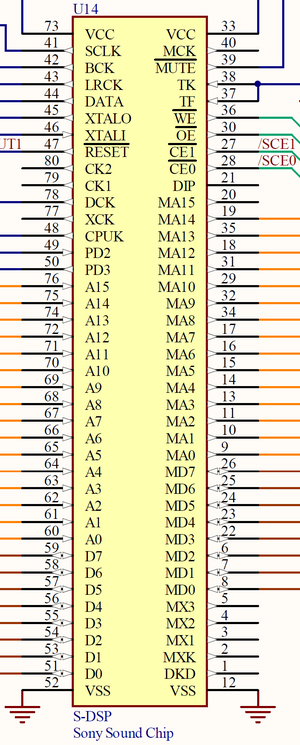We've just updated MediaWiki and its underlying software. If anything doesn't look or work quite right, please mention it to us. --RanAS
S-DSP: Difference between revisions
From SnesLab
(page 3-7-1 of Book II) |
(∴) |
||
| Line 3: | Line 3: | ||
The '''S-DSP''' is the digital signal processor. It produces audio for the [[DAC]] and is controlled by the [[S-SMP]]. It is clocked by [[X2]]. | The '''S-DSP''' is the digital signal processor. It produces audio for the [[DAC]] and is controlled by the [[S-SMP]]. It is clocked by [[X2]]. | ||
It has 128 registers (DSPRAM) that can be manipulated by the S-SMP, some of which serve no hard-wired purpose and can be used as general-purpose RAM. | It has 128 registers (DSPRAM) that can be manipulated by the S-SMP, some of which serve no hard-wired purpose and can be used as general-purpose RAM. Registers with a ∴ before their name are written to by the S-DSP itself during active processing. Here are some of 128: | ||
{| class="wikitable" | {| class="wikitable" | ||
| Line 24: | Line 24: | ||
| 07 || GAIN | | 07 || GAIN | ||
|- | |- | ||
| 08 || | | 08 || ∴ENVX | ||
|- | |- | ||
| 09 || | | 09 || ∴OUTX | ||
|- | |- | ||
| || | | || | ||
| Line 44: | Line 44: | ||
| 6C || FLG | | 6C || FLG | ||
|- | |- | ||
| 7C || | | 7C || ∴ENDX | ||
|- | |- | ||
| 0D || EFB | | 0D || EFB | ||
Revision as of 03:37, 18 December 2023

S-DSP in region D4 of the jwdonal schematic
The S-DSP is the digital signal processor. It produces audio for the DAC and is controlled by the S-SMP. It is clocked by X2.
It has 128 registers (DSPRAM) that can be manipulated by the S-SMP, some of which serve no hard-wired purpose and can be used as general-purpose RAM. Registers with a ∴ before their name are written to by the S-DSP itself during active processing. Here are some of 128:
| Address | Register |
|---|---|
| 00 | VOL (L) |
| 01 | VOL (R) |
| 02 | P (L) |
| 03 | P (H) |
| 04 | SRCN |
| 05 | ADSR (1) |
| 06 | ADSR (2) |
| 07 | GAIN |
| 08 | ∴ENVX |
| 09 | ∴OUTX |
| 0C | MVOL (L) |
| 1C | MVOL (R) |
| 2C | EVOL (L) |
| 3C | EVOL (R) |
| 4C | KON |
| 5C | KOF |
| 6C | FLG |
| 7C | ∴ENDX |
| 0D | EFB |
| 1D | --- |
| 2D | PMON |
| 3D | NON |
| 4D | EON |
| 5D | DIR |
| 6D | ESA |
| 7D | EDL |
| xE | --- |
The highest sound frequency that the S-DSP can produce is 16kHz, because of the 32kHz rate that sample-points are output. [1]
References
- https://problemkaputt.de/fullsnes.htm#snesapudspbrrpitch
- page 3-7-1 of Book II of the official Super Nintendo development manual
